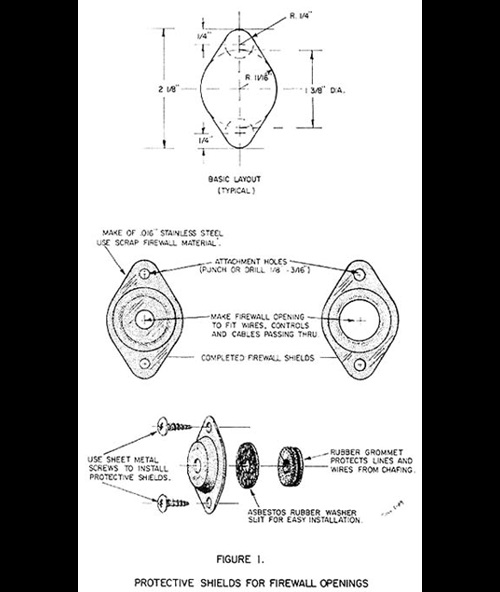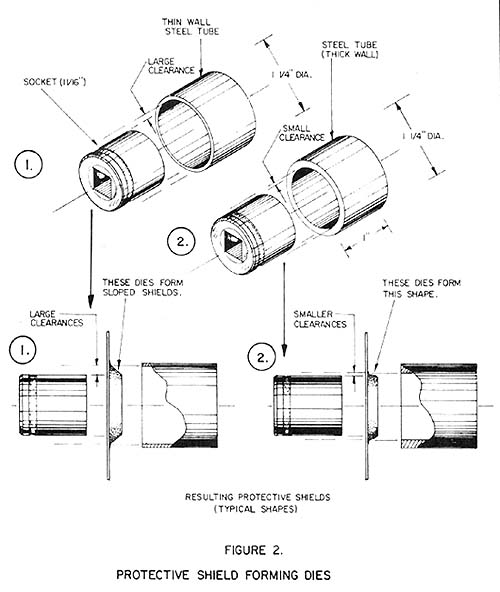How to Make Firewall Grommet Shields
By Tony Bingelis (originally published in EAA Sport Aviation, May 1989)
Ever since the publication of my book, Firewall Forward, five years ago, I have been receiving countless queries asking for possible sources for the firewall shields/grommets illustrated on pages 64 and 66. It seems that most builders would prefer using those neat little rascals instead of sealing the firewall with a rubber grommet and some messy sealant.
Because of the difficulty builders experience in sealing the firewall, I can understand why most builders like to use bulkhead fittings wherever they can as the preferred way to pass plumbing through the firewall. Properly installed, bulkhead fittings do not need any further protection or form of sealant.
Unfortunately, bulkhead fittings cannot be used everywhere so builders continue to seal firewall openings with rubber grommets and dabs of silicone adhesive "frosting" around the wires, cables or controls passing through the firewall. This "better than nothing" solution usually results in a messy appearance. Besides, the treatment is not fire resistant - far from it.
More recently, a high temperature red silicone adhesive has become commonly available at auto parts stores. Although it is capable of withstanding temperatures of 500 to 600 degrees F., it, too, falls short of preventing flame penetration for any length of time.
You should realize that your firewall is supposed to act as a flame barrier between the engine compartment and you in the cockpit. As such a barrier, it ought to be capable of resisting the penetration of flames for 15 minutes. Theoretically at least, that would give you enough time to get the airplane on the ground safely.
Stainless steel firewall shields, installed around wires, cables, engine controls and through rubber grommets/asbestos washers, will provide the ultimate protection against flame penetration of the firewall.
Sources For Firewall Grommet-Shields
First, for the record, I do not know first hand of a reliable, readily available commercial source for those firewall shields - unless, that is, you are willing to make your own.
Both Piper and Cessna aircraft have long used firewall grommet shields (or plates as Piper refers to them). Perhaps more Pipers have more of them installed per aircraft than do any of the other certificated aircraft.
That being the case, you would assume that a well stocked Piper (or Cessna) parts department should have them, or at least be able to obtain whatever you need. Apparently this is not so. At least not in this neck of the woods . . . and I think I understand why.
When an aircraft leaves the plant, it is complete and resplendent down to its very new protective firewall shields screwed to the firewall. During the life of the aircraft there is absolutely no need to remove these protective shields. This means it is most unlikely that any Cessna or Piper owner would ever need such a part. So, why should any parts department stock them? Nevertheless, you would think they could, at least, find one or two part numbers in their catalogs for the things and order them for you.
If you want to check out your local Piper or Cessna parts departments for these shields, here are some typical part numbers you can ask for.
Cessna - Various aircraft models have these firewall grommet shields installed.
(a) S-352 is a common single place shield.
(b) S1095-1 is a two-piece split shield (order two pieces per installation). The dash numbers run from -1 through -6 for the most frequently installed sizes. A S1095-4, for example, accommodates 1/2" diameter wire bundles. The larger the dash number the larger hole is in the shield and the larger the wire bundle it can accommodate.
Piper - Try this part number, PN 18321-00. As mentioned above, I think Piper calls their firewall shields "plates".
Anyway, these are the best I could come up with from my very limited reference library.
My own preferred source for these firewall shields (when I can find some) is, you guessed it - the Fly Markets at Oshkosh, Sun 'n Fun or Kerrville, TX.
There is yet another source. I have frequently relied on this as a more positive source - some locally wrecked aircraft, or an aircraft salvage yard.
Aircraft salvage yard operators are usually quite accommodating and will allow you to remove what you need from one of their "junked" aircraft's stripped firewalls . . . and at a reasonable price, too. Actually, if you are buying other parts, he may not even charge you for the two or three shields you need.
These firewall shields are attached to the metal firewall with two cross point sheet metal screws. Ordinarily, these are not stainless steel screws and they often become heavily rusted. This, of course, may make the removal of some of them difficult. Don't waste your time - go on to those easier to loosen.
If you do plan a trip to some aircraft salvage yard to liberate a few firewall grommets, take along a cross-point screwdriver (and a regular one, just in case) . . . also a pair of diagonals to cut wires and cables, if necessary.
No aircraft salvage operation in your area? Well, there is another alternative and that's what this article is really all about. Simply make your own firewall shields . . . you may even enjoy doing it.
Here's how the simple technique for making these little grommet shields came about. A local Starduster Too builder learned from me that there was no local source, and the only way he could get the firewall shields he wanted was to salvage them. This was O. K. with him as he was making a trip to Kansas salvage yards anyway. The trip resulted in the acquisition of a lot of goodies but, guess what . . . he forgot to get those firewall grommet shields he wanted so badly.
Another trip to Kansas would have been too expensive so the only normal thing for a homebuilder to do was to make his own. But . . . how?
As it turned out, the process was really quite simple and we were even able to work out an easy-to-follow procedure for you.
The Procedure
You won't need much in the way of equipment or materials.
1. The material to use is thin (.015") stainless steel . . . a few scrap pieces will do. Stainless steel is very ductile and easily formed. Do not use aluminum . . . its melting point is far lower than that of steel - something in the range of 850-1200 degrees F.
2. You will also need a large socket wrench socket, and a short piece of steel tubing that fits loosely over the end of the socket.
3. A small scrap piece of soft pine about 3/4" x 2" x 4" to be used as a back-up block.
4. A large bench vise.
5. A pair of large metal tin snips.
With these five pieces of material and equipment at hand, you are ready to start manufacturing your own custom made firewall grommet shields.
The basic idea is to use both the socket and the short tubing length as dies, and your bench vise as an arbor press. You merely center the thin piece of stainless steel piece between the socket and the tubing, slip the assembly into the vise and squeeze. That's about it.
Now for the details
Figure 1 shows the basic shape and dimensions typical of firewall shields. You can make yours larger or smaller to suit your needs. The only change would be to substitute a smaller size socket and a proportionately smaller piece of tubing as dies. The forming procedure would remain the same.
As you can see in Figure 2, the amount of clearance between the two "dies" determines the external shape (style) of the formed shield.
You probably have already examined the photo sequence and studied the drawings so you should be familiar with the general procedure.
1. Begin by taking a scrap of stainless and holding the socket against it on one side, and the back-up block of soft wood on the other. Insert this assembly in your vise and tighten the vise until you see the socket actually sink about 1/16" into the stainless piece. That soft wood backing block crushes easily and allows this to happen.
2. Remove the assembly from the vise and you will see a definite circular indentation in the stainless piece. This indentation is necessary as it will allow you to accurately center the short piece of large diameter tubing over that embossed ring.
3. Place the socket back in its original position and, again, insert the whole assembly in the vise - this time with the large tube taking the place of the wood backing block. Squeeze the assembly until the socket is deeply imbedded into the stainless . . . approximately 1/8".
4. Then, without removing the now distorted piece of stainless, start to straighten the distorted metal edges any way you can. Tapping the stainless steel part with a small hammer - using a flat metal back-up block (bucking bar) held behind - is a good way to start. Tap away until the surplus metal edges are fairly free of large ripples and waves.
5. Remove the formed stainless part from the vise and cut away most of the excess metal with a pair of sharp sheet metal tin snips.
6. Complete straightening the edges of the formed stainless piece.
7. Use a thin strip of metal as a straight edge and mark the centers for the installation and attachment holes. Drill the screw holes with, say, a No. 19 drill bit, or punch them out with a Whitney punch. As for the center hole through which the wires, cables or engine controls will be routed, drill it to the size opening you will need.
8. Trim and smooth the edges and round the ends of the shield on a disc sander fitted with carburundum sandpaper. This edge trimming can also be done on a bench grinder with a fine wheel. Remember, the material you are working with is tough stainless and it can be very difficult to drill, trim and shape.
After you get the hang of it, you should be able to make one grommet shield in 10 minutes - and it will be every bit as good as a factory made one.
Go ahead and try making a few - it's quite satisfying. You could always give them to a builder/friend if you don't need them for yourself.
Inspecting Firewall Shielding Effectiveness
Remember, these firewall shields are to be used with rubber grommets and, sometimes, an asbestos washer behind them. The purpose of the grommet is to closely hug the wires, cables or controls passing through the firewall and protect them from being chafed or cut by the sharp edges of the firewall opening and the shield as well.
To evaluate the effectiveness of your firewall shield installations, you'll need help. Have someone stand outside the aircraft with a bright drop light or flashlight that he can shine on each shielded firewall opening.
With you in the cockpit, you should not see any sign of light shining through any of the firewall openings. If light can shine through, carbon monoxide and even flames can also get through.
In Conclusion
Talk about options. Now, you can try to buy new factory made firewall shields, look for them at the aviation flea markets, salvage them or, best of all, make them yourself.
My Technical Advisor this month is Wayne Tabb, Austin, TX . . . a Starduster Too builder.


